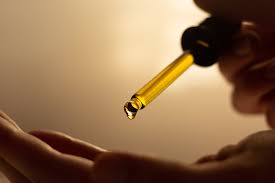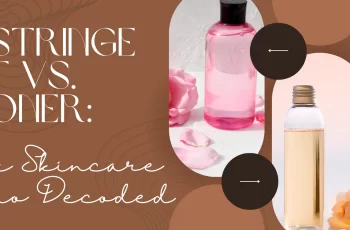Can I Use Lactic Acid with Rosehip Oil?
Lactic acid and rosehip oil are both highly effective skincare ingredients. With each of them delivering impressive results on the skin, it’s no wonder that so many of us are wanting to team these powerhouses together. The question is, can you use lactic acid with rosehip oil? This is exactly what we will be figuring out in today’s blog post, so stick around if you wanted to find out more.
The main difference between them is the fact that rosehip oil is often considered the more natural ingredient, which is a common misunderstanding due to lactic acid having such a scientific sounding name. In fact, many will be surprised to hear how lactic acid itself is derived from natural sources, such as milk and other dairy products.
Before we dive in, let’s have a brief recap of the main benefits are of lactic acid and rosehip oil.
What is rosehip oil?
Rosehip oil are the fruits of the rosebush and formulated into various beneficial products, such as supplements and skincare products.
Rich in essential fatty acids, such as oleic acid, palmitic acid, and linoleic acid.
Contains vitamin C and vitamin A all of which can combat damage caused from free radical exposure, such as pollution, central heating, and other environmental aggressors.
Helps to combat mild to moderate acne and breakout flare-ups.
Reduces signs of hyperpigmentation and dark spots.
Targets fine lines, wrinkles, and other signs of premature ageing.
If you wanted to find out more about rosehip oil, there is extra information over on the Skin School website.
What is lactic acid?
Derived from soured milk and other dairy products, you’ll also find certain fruit sugars are used in formulas too.
A member of the family of acids called alpha hydroxy acid, also known as AHA.
Known for being the gentlest of the AHAs with a molecular size that is very large meaning it doesn’t cause unwanted irritation.
Works on the outer surface and slough away the build-up of dead skin cells, dirt, and debris that sit on the skin which can often lead to several concerns.
Helps to improve the signs of ageing whilst stimulating the production of collagen.
Contains a unique benefit of humectant traits meaning it locks moisture into the skin and keep the protective barrier strengthened.
If you wanted to find out more about lactic acid, you can check out our dedicated blog post about lactic acid and its benefits for the skin.
Can you use lactic acid and rosehip oil together?
Yes, you absolutely can! This is because each of these ingredients are found in different formulas resulting in them being applied to the skin, leaving plenty of time in between to ensure the skin’s pH levels rebalance and avoid unwanted irritation.
As for figuring out when to apply each of these actives, the general rule of skincare is to start by using the thinnest consistency and working your way up to the thickest. This makes it very simple to figure out the best way of applying lactic acid and rosehip oil. Seeing as the latter is an oil and needs to be applied to the skin as one of the final steps of your daily skincare routine. By layering the products in this order will allow each ingredient to penetrate and reach the right areas of the skin.
Can you use oil after lactic acid?
Yes, you can, as I have already mentioned, to gain the optimal results for the skin, it is best to start with the thinnest consistency and work your way up to the thickest products. A basic skincare routine would look like the following, starting off with a cleanser, exfoliating toner, eye cream, serum, face oil, moisturiser, and finally finishing off with an SPF during your morning routine.
Due to rosehip oil being highly nourishing and hydrating for the skin it is a beneficial and effective ingredient to follow lactic acid, just ensure you leave enough time to prevent any irritation, redness, or other flare-ups.
Can you use AHA with rosehip oil?
You can, but if you use these ingredients properly you will have effective results on the skin. The main concern you need to remember is the fact that rosehip oil contains vitamin A, also known as retinol which is known for being one of the most potent skin ingredients. To avoid the skin from becoming irritated there are a few things you can do, first, as I have mentioned previously, ensure you leave enough time in between applications to allow the pH levels in the skin to rebalance. Another favoured way of using these actives is applying them during different times of the day. You could also alternate the different day you use each ingredient too; this is the option favoured by those with a dry skin type that are prone to sensitivity and redness.
When should you use rosehip oil in a routine?
For the best results, many skincare experts find the best results for rosehip oil is to use it twice a day in the morning and evening. Applying it will be at the later stage of your skincare routine once you have fully cleansed the skin and applied liberal amounts of serums, especially if the serums are enriched in hyaluronic acid and other hydrating ingredients, such as niacinamide.
Word of caution, if you are introducing any new ingredients or formulas to your routine, you must first seek the advice of a doctor or dermatologist. You can also perform a patch test for 24 hours before applying the formula to your face for peace of mind.
Can I use rosehip oil every day?
Yes, you can use rosehip oil every day, twice a day. This is dependent on how reactive your skin is to the ingredient, this is why I suggest performing a patch test as I have already mentioned.
There you have a little more detail about using lactic acid and rosehip oil together. Don’t forget, if you have any further questions you can find us on Instagram.
DQH Knowledge drop: In your 20s, your skin cell turnover decreases. (Cell turnover is a key component in keeping your skin youthful.) You know what else slows down? Your collagen production. Starting in your 20s, collagen decreases by about 1 percent per year. Should you want to prevent fine lines and wrinkles, start by eliminating behaviors that contribute to premature aging. “If it’s bad for you, it’s bad for your skin,” says dermatologist Michel Somenek.
“Cigarette smoking reduces blood flow to the skin and causes premature wrinkling and a dull skin texture. Making the repeated pursed motion to inhale can also cause smoker’s lines. Alcohol and recreational drugs are toxins for the skin that damage its cellular structure and DNA,” Somenek tells us. “The faster you eliminate vices while you are young, the better chance your skin and body have to recuperate.” Also, adopting an anti-aging routine in your 20s is key. After all, the best offense is a good defense. We spoke to Somenek and experts Joshua Ross and Audrey Kunin to find out more.
Keep reading for the best anti-aging products for your 20s, according to skincare professionals.
Sunscreen
“We all know that the sun is the number one cause of skin aging and starting the prevention in your 20s is very important,” Ross says. “The majority of your sun damage won’t start to appear until you’re in your 30s, so don’t wait until you see it surface or you’ll be behind the curve. Stay ahead of it with a good-quality zinc-based sunscreen worn daily.”
Farmacy Green Defense Daily Mineral Sunscreen
An invisible sunscreen with SPF 30, plus botanical extracts meant to protect skin with tons of antioxidants. Bonus: It’s clean and fine to use under makeup.
Bareminerals Complexion Rescue™ Tinted Moisturizer Broad Spectrum SPF 30
Although we recommend you use your SPF and moisturizer separately, we also understand moments when you don’t have time or energy for that extra step. For those times, this bareMinerals moisturizer is a great thing to have on hand.
Vitamin C Serum
“A great introduction to anti-aging is to start with a vitamin C serum in your morning skincare routine,” Ross says. “It’s a powerful antioxidant that will neutralize free radicals and brighten the skin.” He adds that it’s a great way to counteract the effects of the sun’s harmful rays, which, as previously mentioned, are among the biggest causes of premature aging.
Drunk Elephant C-Firma™ Vitamin C Day Serum
The Drunk Elephant C-Firma is a lightweight serum that promises to give skin a glow by combining the brightening powers of vitamin C with ferulic acid, l-ascorbic acid, and vitamin E. The included sodium hyaluronate is meant to replace hydration loss, so you shouldn’t have to deal with any irritation.
Sunday Riley C.E.O. Rapid Flash Brightening Serum
This potent serum is jam-packed with vitamin C (15 percent, to be exact), which means it’s a potential superstar at both brightening skin and dousing it in antioxidants.
Peptides
Using peptides on your skin has many benefits, says Somenek. “The skin barrier is what defends the body against pollution, UV rays, bacteria, and toxins. It can be damaged by several everyday factors. Using topical peptides aids in building a stronger barrier,” he says. “Peptides comprise elastic fibers, which are a type of protein. These fibers help to make skin appear taut and firm. Peptides can also help repair damaged skin, relieve inflammation, and even out skin tone. Some peptides can kill acne-causing bacteria that is common in 20-somethings.”
Kunin agrees, saying, “Peptides are an excellent entry point for supporting collagen.” She recommends looking for face and eye treatments that contain these collagen-boosting powerhouses.
Charlotte Tilbury Magic Eye Rescue Cream
This Charlotte Tilbury super-emollient eye cream has a base of coconut oil and shea butter (read: it’s incredibly hydrating). Botanicals plus peptides are meant to help reduce dark circles and boost collagen, respectively.
This creamy moisturizer serves up potent collagen-boosting peptides and pycnogenol, and antioxidant-rich vitamin C. “Instead of sitting on top of the skin, peptides penetrate the outer layer so they go deep. The ‘signals’ they send tell the cells to produce elastin and collagen, which are needed for youthful-looking skin,” explains Somenek.
At-Home Peel Pads
Remember that skin cell turnover fiasco we talked about earlier? One way to help support it is by exfoliating. “Exfoliation is important to help keep skin fresh and luminous,” Kunin says. She recommends using at-home peel pads as an easy and effective way to exfoliate.
“The goal in your 20s is to fight the slowing pace of cell turnover. It is wise to use products that gently exfoliate, yet still remove oil and other impurities. Products that have Alpha Hydroxy Acids (AHA) or Beta Hydroxy Acids (BHA) are a good choice.”
According to Somenek, you should only exfoliate two to three times a week. “People of all ages are guilty of over-exfoliating and that can be too much of a good thing,” he says.
Dermadoctor Kakadu C Intensive Vitamin C Peel Pad
A few swipes of this Derma Doctor powerful peel pad promise to leave your skin glowing and smooth, thanks to the seven (yes, seven) types of chemical exfoliants, including AHA and BHA. It also contains vitamin C via Kakadu plum extract for added brightening and antioxidant protection.
KEY INGREDIENTS Kakadu plum extract is sourced from the Kakadu plum, a fruit grown in northern Australia. It contains vitamin C, which restores the skin’s natural barrier, increases collagen production, and soothes irritation.
Dr. Dennis Gross Skincare Alpha Beta® Universal Daily Peel Pads
These are the gold standard of peel pads, with a cult following and over 900 five-star reviews on Sephora. They’re easy to use and contain a blend of anti-aging exfoliating acids.
Emollient Night Cream
“In your 20s, you need to start upping the hydration in your skincare routine. You may have been cautious of over-moisturizing because of acne in your teens, but as you enter your 20s, your skin transitions and becomes drier,” Ross says. “I recommend an emollient night cream added into your evening skincare regimen.”
“Twenty-somethings need to make sure that they are not using creams that will clog their pores and cause excess oil production,” says Somenek. Opt for non-comedogenic products.
Cerave Skin Renewing Night Cream
One great choice is the CeraVe Skin Renewing Night Cream, which is a non-comedogenic night cream that leaves skin soft and glowy. It combines the moisturizing powers of ceramides and hyaluronic acid.
RoC Retinol Correxion Max Hydration Creme
“The best night cream ingredients contain retinol, benzoyl peroxide, and/or salicylic acid or hyaluronic acid. The goal is to moisturize, yet remove excess oil,” says Somenek. This Roc Retinol Correxion cream fits the bill as it contains both hyaluronic acid and retinol so it promises to moisturize while also being non-comedogenic.



